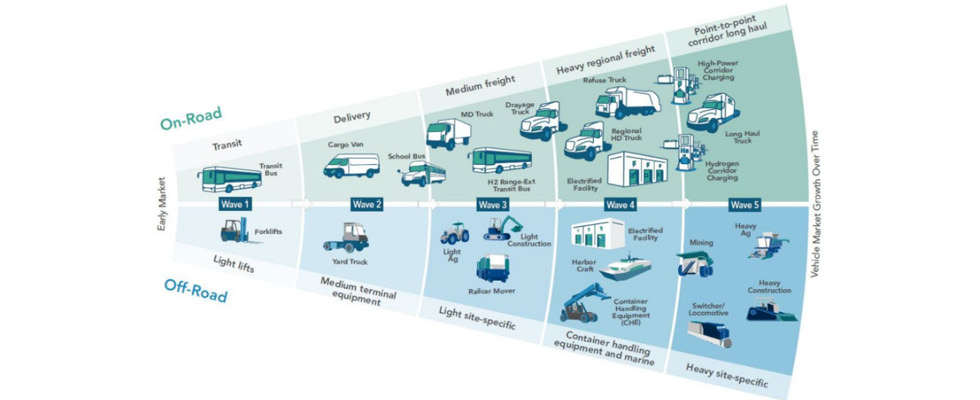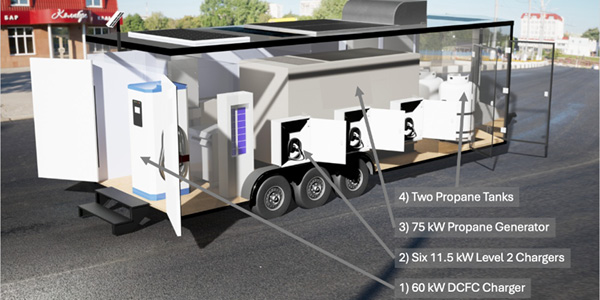
The transition to electric vehicles (EVs) is gaining momentum, with widespread adoption across various industries. Electric buses, including school and transit buses, last-mile delivery vans, port terminal tractors and heavy-duty drayage trucks (Class 8 trucks that transport containers and bulk freight between the port, rail facilities and distribution centers), are increasingly making the transition to electric power.
To support this transition, billions of dollars in grants are being allocated for electric school and transit buses, while significant incentives are available for electric trucks, ranging from last-mile delivery vans to terminal tractors and drayage trucks.
There have been significant investments in EVs across various industries. Governments and local authorities are making substantial investments in electrifying their school bus fleets. With the backing of substantial federal funding, the deployment of zero-emission transit buses is set to accelerate. Many last-mile delivery vehicles, essential for e-commerce and urban deliveries, are switching to electric power. Moreover, terminal tractors at ports and heavy-duty Class 8 drayage trucks — responsible for transporting cargo to distribution centers — are also transitioning to electric power.
Delays in Electrical Infrastructure
However, the transition to electric vehicles faces a significant obstacle: the slow development of necessary electrical infrastructure. Projects crucial for supporting the expanding fleet of electric vehicles are often beset by lengthy delays, spanning between one to three years. The procurement of essential equipment, such as transformers and switchgear, can take over a year and 18 months, respectively.
Moreover, the construction of new substations can take up to five years, creating a substantial bottleneck that hinders the widespread adoption of electric vehicles. These infrastructure delays pose a significant challenge to electric vehicles.
Rural areas face an even more daunting challenge: insufficient power supply. Many rural locations lack the necessary power infrastructure to support the addition of electric vehicle charging stations. Installing such infrastructure is often not economically viable for electric utilities due to the low population density and high costs.
Many rural locations lack the necessary power lines, substations and transformers required to support additional electrical loads. Upgrading this infrastructure involves significant investments and long timelines. In some cases, the existing power grid may be unable to handle the increased demand from electric vehicle charging, leading to reliability issues and potential blackouts.
The economic viability of installing EV charging infrastructure in rural areas is a significant concern. With lower population densities and fewer vehicles, the return on investment for electric utilities is often insufficient to justify the costs, further reducing the potential economic justification for infrastructure upgrades in these areas.
Alternative Solutions
In response to these challenges, alternative solutions are emerging to provide reliable and efficient EV charging in locations with extensive delays in electrical infrastructure and rural areas with insufficient power. One of the most popular solutions is the use of off-grid electric vehicle charging powered by propane or renewable propane.
How does propane power an electric vehicle? This approach leverages propane or renewable propane to power a propane generator. These generators can produce up to 240 kW of 480V power, sufficient to power multiple EV chargers simultaneously. The electricity generated by the propane generator is used to charge the batteries of electric vehicles, providing a reliable and efficient charging solution.
Why Propane?
 Propane offers several advantages that make it an attractive option for off-grid electric vehicle charging. Propane is a reliable source of energy, available in virtually every community across the country. Unlike electrical infrastructure, which can be prone to outages and supply issues, propane provides a consistent and dependable energy source. This reliability is crucial for ensuring electric vehicles have access to charging when and where they need it.
Propane offers several advantages that make it an attractive option for off-grid electric vehicle charging. Propane is a reliable source of energy, available in virtually every community across the country. Unlike electrical infrastructure, which can be prone to outages and supply issues, propane provides a consistent and dependable energy source. This reliability is crucial for ensuring electric vehicles have access to charging when and where they need it.
Using propane for EV charging can result in significant cost savings. Propane is generally less expensive than other fuels, and the cost of propane generators and infrastructure is lower compared to the cost of upgrading or installing new electrical infrastructure. Additionally, the maintenance costs for propane-powered systems are lower, further reducing the overall cost of ownership.
Propane is a clean-burning fuel with low emissions. It has a lower carbon intensity than the electrical grid in 38 states and renewable propane has a lower carbon intensity than the grid in 49 states. Propane produces fewer sulfur oxides, nitrogen oxides and particulate matter compared to other fuels, making it an environmentally friendly option for EV charging. Charging electric vehicles using propane autogas exceeds emissions standards, while reducing both operational and maintenance costs. Moreover, propane is widely available, present in every community across the country, ensuring easy access for all.
What Is the Opportunity?
The opportunity for propane in the electric vehicle market is substantial. As industries increasingly adopt electric vehicles, the demand for dependable and efficient off-grid charging solutions is on the rise. Early adopters of electric technology include school buses, transit buses, last-mile delivery vehicles, terminal tractors and drayage trucks, paving the way for propane-powered charging solutions to play a key role in supporting this transition.
The Clean School Bus Program has resulted in 8,500 electric school buses being awarded, ordered, delivered or currently in operation. The electric school buses typically have about 190-kWh (kilowatt hour) batteries. Charging each bus from 20% to 90% each night requires approximately 130 kWh. Charging eight buses nightly equates to over 1,000 kWh, or 1 MWh (megawatt hour), of energy.
Over a year, this translates into more than 200 MWh of energy annually, requiring more than 40,000 gallons of propane or renewable propane. A small school may have eight buses, while a large school could have 200 buses. This is a sizable amount of propane required for charging electric school buses.
Transit Buses
In June 2023, the Federal Transit Administration announced nearly $1.7 billion in funding for 130 transit projects across 46 states and territories. Many of them will need to be powered with off-grid EV charging. These Class 7 or 8 transit buses, which are 30 feet or more in length, typically have over 200-kWh batteries. Charging each bus from 20% to 90% each night requires about 150 kWh. Charging 12 buses nightly requires 1,800 kWh (1.8 MWh) of energy.
Annually, this translates into more than 730 MWh of energy, which requires almost 100,000 gallons of propane or renewable propane. Small transit agencies may have a dozen transit buses. A large transit agency may have over 100 transit buses.
Looking to the Future
The shift to EVs marks a significant milestone in reducing emissions and promoting sustainability. However, delays in electrical infrastructure development and rural power shortages present significant hurdles. Propane, with its reliability, cost-effectiveness and low emissions, offers a compelling solution for recharging electric fleets.
Forward-thinking propane marketers are capitalizing on this opportunity to fill the gaps in electric vehicle charging infrastructure. As the transition to sustainable transportation continues, leveraging propane for off-grid electric vehicle charging can play a vital role in bridging the infrastructure gap, ensuring a seamless and efficient transition.
Off-grid EV charging is emerging as an essential propane accessory, offering propane marketers a new avenue for growth and innovation.


